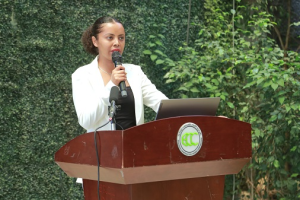
The construction of the Abbay Hydroelectric Dam is reaching completion with the unwavering support of the public from all walks of life and the government’s unwavering stance. The construction of the Dam’s cornerstone was placed on April 02, 2011. During that time, different optimist and pessimist voices were echoed about the achievement of the Dam with Ethiopia’s own capacity-resources, finance, and expertise. However, the opposite has happened. Ethiopians at home and abroad stand together as one to realize the largest African Dam for the past 10 plus years.
All in all, the Dam has now seen its final stage and its water catchment has become two times the largest Ethiopian Lake Tana. Nowadays, the Abbay Hydroelectric Dam has become a role model to the people of Africa as it practically witnessed the power of “nothing is impossible”. Ethiopians have now pioneered the idea of self-financing huge projects with own-self. Apart from this, the construction also paves the way for cooperation among the Nile Riparian States.
Therefore, history is now in the making at Guba Town in Benishangul Gumuz State where the largest African Dam is going to operate with full potential in the near future.
Recently, Prime Minister Abiy Ahmed (PhD) launched the 3rd and 4th turbines of the Abbay Dam.
Premier Abiy posted on his official Facebook page that the remaining units are proceeding according to plan.
More good news has emerged from Guba for the lower Abbay basin countries, the PM underscored stating that along with the uninterrupted flow of the river, the Dam’s spillways have been opened, releasing an additional 2,800 cubic meters of water per second.
“The Dam plays a crucial role in managing water flow, mitigating flood risks, and ensuring that downstream nations receive a steady supply of water, particularly during droughts,” Abiy noted.
This carefully regulated release will significantly enhance agricultural productivity, boost power generation, and improve resource utilization throughout the region, Prime Minister Abiy stressed.
On his part, Former Dam negotiator and water resources researcher Fekahmed Negash told local media that the commissioning of additional two turbines of the Abbay Hydroelectric Dam demonstrates Ethiopia’s positive intention to interconnect the region through electric power supply.
According to the researcher, the functioning of all turbines could foster trust among basin countries.
Fekahmed said that while the entire turbines of the Dam were originally scheduled to be operational by now, unforeseen circumstances have prevented the full implementation in this regard.
The two turbines already commissioned and the recent additions of two more turbines will double the power supply, he added.
The researcher emphasized that the commissioning of the turbines is crucial not only for augmenting Ethiopia’s energy supply but also for demonstrating the country’s effort to connect the region with electric power.
In its recent annual performance, the Ethiopian Electric Power, Dam generated 17 percent of the total energy from only 2 of the 13 turbines in the 2023/24 Ethiopian fiscal year.
Fekahmed further stressed the need for reinforcing maximum efforts on putting the remaining turbines into operation would be paramount for augmenting the Dam’s power generating capacity.
The other expert from the African Economic Research Consortium PhD Fellow Habtamu Girma highlighted that the Dam’s full operation would greatly enhance power accessibility and resolve electricity issues faced by investors.
Habtamu, an Economics Assistant Professor formerly with Jigjiga University, noted that many investment sectors and manufacturing industries currently operate at just 30 percent to 40 percent of their total capacity due to unreliable power access. The Dam’s completion, he emphasized, would provide a substantial boost to industrial and investment sectors, directly supporting employment, increasing production and productivity, and foreign exchange generation not only for Ethiopia but also for neighboring countries.
Citing World Bank data and global studies, the Expert pointed out that in Sub-Saharan Africa, the high cost of electricity- averaging 0.13 USD per kWh-can be attributed to power shortages. The completion of Ethiopia’s Dam project, therefore, will alleviate these costs, benefiting investment and other integrated sectors.
He further stressed that, beyond its economic benefits, the Dam will have a significant global impact by improving water utilization for both upstream and downstream countries through better water flow management and reduced water loss and evaporation.
By preventing sedimentation in the dams of lower riparian countries, the project could also enhance their energy efficiency by 1 percent annually. Additionally, according to the Ethiopian Economic Association, Sudan is projected to see a 1.4 percent improvement in its economy by 2035 as a result.
The Expert also mentioned that Ethiopia’s flagship project is expected to contribute to a 1.5 percent growth in GDP while supporting sustainable development principles across agriculture, health, and environmental sectors. The development of lodges and artificial lakes around the Dam is anticipated to boost the tourism sector and fish production, creating numerous jobs.
Highlighting the scenario in Sub-Saharan Africa, Habtamu asserted that improved power access would enhance investment efficiency, benefiting not only Ethiopia but also the entire East African region.
In sum, watching the Abbay River’s water smoothly flowing to the Dam and generate thousands of electricity was the dream of every Ethiopian. Now, that dream has come true and the Dam has reached its final accomplishment with the active participation of every Ethiopian at home and abroad. Witnessing such a huge project accomplishment is worthy and sought to motivate every Ethiopian. Apart from fulfilling the country’s electricity demand, the full operation of the Dam will have enormous socio-economic benefits.
BY TEWODROS KASSA
THE ETHIOPIAN HERALD TUESDAY 3 SEPTEMBER 2024





